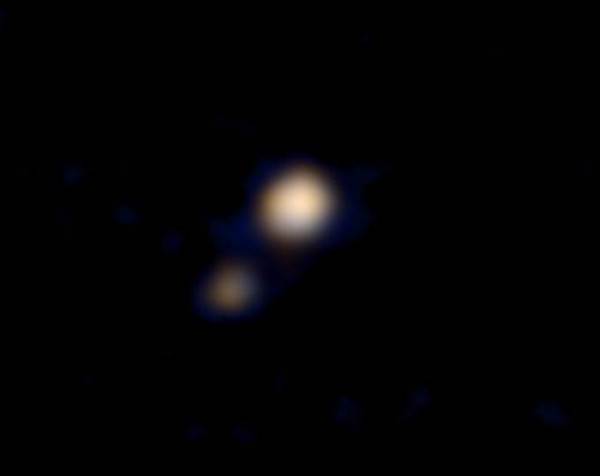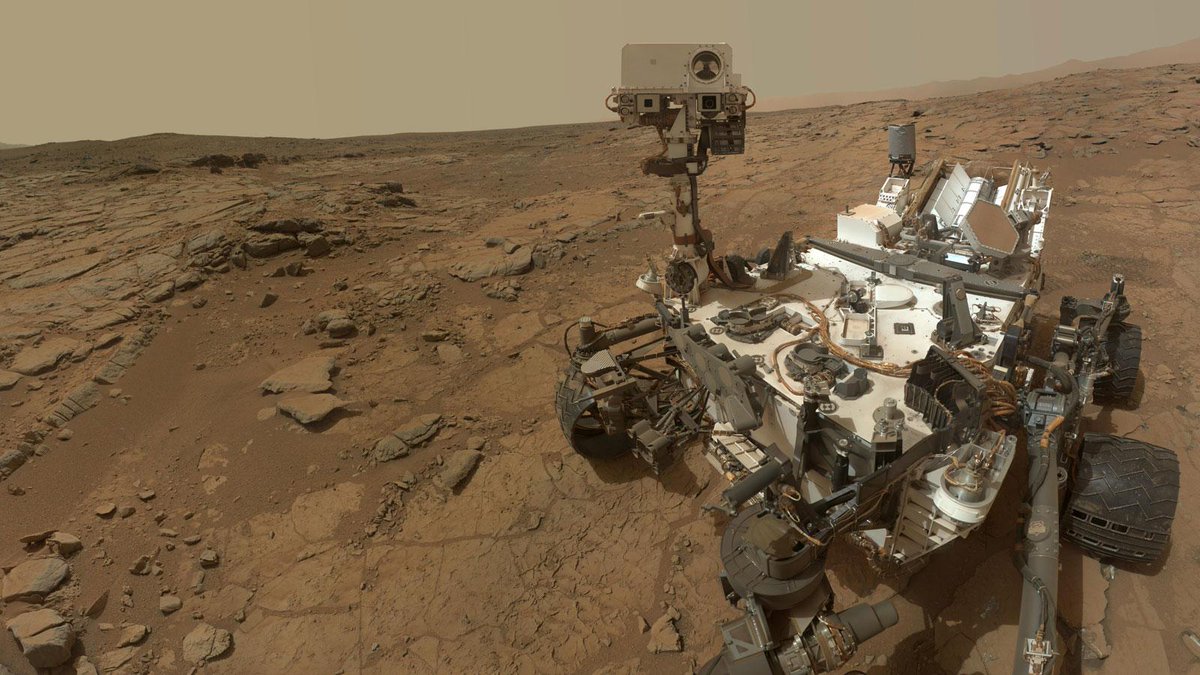 |
| ***The "dwarf planet" Pluto and it's moon Charon in living color. |
ON (April 14, 2015), NASA’s New Horizons spacecraft team released this tantalizing first color image of Pluto and its Texas-sized moon Charon. The team called this image a preliminary reconstruction, which they said will be refined later. The spacecraft acquired the image from a distance of about 71 million miles (115 million kilometers)-roughly the distance from the sun to Venus. New Horizons is now only three months from its historic encounter with Pluto. The flyby through the Pluto system will take place on July 14, at which time the spacecraft will deliver color images that eventually show surface features as small as a few miles across. The Color pictures are stunning . I have waited so long to see what Pluto is actually like , but there are tantalizing clues to this miniature world . On one level, New Horizons caps a 50-year quest to tour the planets beyond Mars. First envisioned in the mid-1960s, the grand tour of flybys morphed into the Voyager 1 and 2 missions. Launched in 1977, these provided the first stunning, close-in observations of Jupiter, Saturn, Uranus, and Neptune. Orbiters to Jupiter and Saturn for more-detailed studies would follow. Pluto, however, was struck from the tour's TripTik. Now, 26 years after Voyager 2's Neptune fly-by, New Horizons is set to introduce a new generation to the awe of seeing new worlds for the first time as something more than remote dots of light.Before you get too excited about interpreting features on the surface of Pluto from this image, you need to realize that it has been enlarged by quite a lot from the original resolution of the camera. If I've done my math right, it's been enlarged by a factor of six. Just for fun, I've "de-enlarged" the image by reducing its size by a factor of six -- these don't show you the data's actual original pixels, but it should illustrate the size of the original pixels. (They would have had to enlarge the image somewhat in order to successfully overlay the separate MVIC frames taken at different wavelengths in order to make the color photo, so there really is no original-resolution version of this picture.) My analysis of the image of Pluto shows that it might not be spherical in shape , rather Pluto looks more like a oblong object that some how has a bulge on it's equator due to the close gravitational pull of it's moon Charon . I also suspect ct that Pluto might be geologically active with volcano's because of tidal "heating" of it's surface . Pluto is bizarre , it is surrounded by almost 10 small moons . One of New Horizon's goals is to hunt for any additional moons as well as any extended debris disk or rings that could remain. The collision that formed Charon also could have led to the presence of an internal ocean on Pluto, at least early in its history,New Horizons will soon see Pluto, and is expected to find new moons and possibly a ring system. Could it find a moon of a moon? Or a moon with rings? Or, is that impossible? Is there anywhere else in the solar system that could have moons with moonlets?
Ceres coming to view.....
<< Ceres, after it was snapped from a distance of 21,000 (33,000 kilometers) on 10 April.NASA has promised that, from here on in, the photos of the world let will be more and more spectacular as Dawn edges ever closer to Ceres – which is the biggest body in the asteroid belt between Mars and Jupiter.Ceres is only 590 miles (950 kilometers) in diameter, which is too small to clear its local neighborhood (the asteroid belt) It is, however, large enough to be spherical. Elliptical bodies can also be dwarf planets if they are in what’s known as hydrostatic equilibrium — basically they have a natural (not lumpy) shape under their own gravity. So Ceres is a dwarf planet like Pluto (721 miles) and Haumea (385 miles). The images above show the north polar region of Ceres at an altitude of 21,000 miles. They were taken on April 10th, but Dawn will continue tightening its orbit over the coming weeks. The images and data it sends back will only get better in the meantime. Two of Dawn’s reaction wheels have failed, which makes it harder to snap pictures from a distance — the entire craft has to be rotated, which uses up fuel. Still, Dawn is close to its ultimate destination and NASA will be able to take a good look at the dwarf planet up close. The map is an enhanced view, offering an expanded range of the colors on
Ceres visible to the human eye. Scientists use this process to highlight subtle differences in color, which can provide insights into the composition of materials on the surface. For example, scientists have not established clear connections between impact craters and the different colors visible here, but they are investigating the possibility.Based on observations from Nasa’s Hubble Space Telescope, planetary scientists have identified 10 bright regions on Ceres’ surface. One pair of bright spots, by far the brightest visible marks on Ceres, appears to be located in a region similar in temperature to its surroundings. But a different bright feature corresponds to a region that is cooler than the rest of Ceres’ surface.The origins of Ceres’ bright spots, which have captivated the attention of scientists, remain unknown. It appears the brightest pair is located in a crater 57 miles wide. As Dawn gets closer to the surface of Ceres, better-resolution images will become available.Dawn's earliest views of Ceres were in black and white, showing us a rocky, pockmarked body. Some unusual bright spots showed in these images, giving scientists plenty to ponder as Dawn moved closer to its goal. Researchers shared Dawn's first color map of Ceres, a fascinating enhanced-color image designed to highlight a variety of surface features.
Mars continues to intrigue .
 |
| Curiosity rover at landing site at Gale crater near Mt. Sharp. ( self portrait ). |
The Planet Mars has been in the news off and on . With some "interesting" hints that Mars was more"earth like" than any of the so called newly discovered exo-planets , that have been credited to orbit their stars near what is called the "Goldilocks zone". Mars is the 4th planet and it occupies nearly the edge of our Goldilocks zone. Mars in our solar system is more close to Earth as you might say take a line from Star Trek a " class M" planet . Mars has all the ingredients for a soup dish in the Creator's plan to make a "second Earth" . Recently as of Another ingredient for life has been found on Mars.NASA announced this week that the Curiosity rover has discovered life-sustaining nitrogen on the Red Planet for the first time. By drilling into Martian rocks, the rover is said to have located evidence of nitrates -- compounds that contain nitrogen “in a form that can be used by living organisms.” Nitrogen, as Discovery News notes, is essential for life, as it’s a building block of RNA and DNA. The space agency was quick to note that "there is no evidence to suggest that the fixed nitrogen molecules found by the team were created by life.”“The surface of Mars is inhospitable for known forms of life,” NASA said. It LEAVES many questions , (1)> again Mars , thanks to the Curiosity Rover has also found evidence of "salty water - brine's" that flow on the surface . Scientists believe they have evidence of liquid water on Mars. It’s only a tiny bit, and only in certain seasons, but this salty water makes the hunt for past life on Mars all the more exciting.We know Mars has water, and we also know that Mars once had liquid water (a whole ocean, in fact) but now it seems we may have evidence of liquid water today. Or during the planet’s spring and winter months, anyway. In a study published Monday in Nature Geoscience, researchers report that the Curiosity rover has found signs that thin layers of super-salty water could form and evaporate frequently on the surface of Mars.The problem with water on Mars is that it doesn't act like water on Earth. The planet’s atmospheric pressure is so low that water acts more like dry ice would on Earth: It goes right from solid to gas, skipping the liquid step we’re used to seeing in the middle. But some water on Mars may get so flooded with salt that its freezing temperature lowers significantly.Curiosity detected salts called (2)> perchlorates, which can absorb water from the atmosphere and turn it into briny liquid. but the possibility for liquid brines on Mars has wider implications for habitability and geological water-related processes. So we have all the "carbon base" elements on Mars right now . Nitrogen and Methane both have been found on Mars . So the question gets deeper , more "discoveries" await us........
NOTES AND COMMENTS:
*** Pluto and Charon are PLANETS and that's that. Done. Over. Finished. Caput. I came to that
realization some time ago and simply ceased even arguing about and whenever I say something about the planet Pluto online, I simply call it "the planet Pluto" and you know what? Nobody even argues with me about it anymore, I think pretty much everyone is in agreement on that point now.Earth and the Moon are also considered a Binary Planet system. This is because the relative size of the Moon is huge, about 1/4 the size of the Earth. In contrast, the Galilean moons of Jupiter are less than 1/100 the size of Jupiter. Only the Earth-Moon and Pluto-Charon have such large comparisons in size. << Dawn just went 900 million miles to create an orbit around an iceball only 590 miles in diameter. It's been making a sling shot round the dark side and is approaching it's fixed orbit position.This photo looks like OpNav 6 w/17%illumination I'm all excited to see OpNav 7 dawn took on the 14th with 49% illumination. (1)> Measurements taken by NASA's Curiosity rover over the last year show a distinct possibility of salty liquid water, or brine, in the Martian soil, according to climate scientists. Readings taken from the rover's Environmental Monitoring Station have tracked temperature and humidity for over a year, while other instruments examined the chemistry of soil and rock samples — giving researchers a wealth of data to pore over. (2)> perchlorates,are the salts derived from perchloric acid—in particular when referencing the polyatomic anions found in solution, perchlorate is often written with the formula ClO4−. Though produced by natural processes, the preponderance of perchlorates on Earth are produced commercially. Perchlorate salts are mainly used for propellants, exploiting their explosive properties.[2] Perchlorate contamination in the environment has been extensively studied as it has effects on human health. Perchlorate has been linked to its negative influence on the thyroid gland. 2007 Phoenix Mars Lander performed the first wet chemical analysis of martian soil. The analyses on three samples, two from the surface and one from depth of 5 cm, revealed a slightly alkaline soil and low levels of salts typically found on Earth. Unexpected though was the presence of ~ 0.6% by weight perchlorate (ClO4−), most likely as a Ca(ClO4)2 phase.[31] [32] [33] The salts formed from perchlorates discovered at the Phoenix landing site act as "anti-freeze" and will substantially lower the freezing point of water. Based on the temperature and pressure conditions on present-day Mars at the Phoenix lander site, conditions would allow a perchlorate salt solution to be stable in liquid form for a few hours each day during the summer.[34]
 |
| Mars , Mercury and Moon , compare with the dwarf planets. |


No comments:
Post a Comment